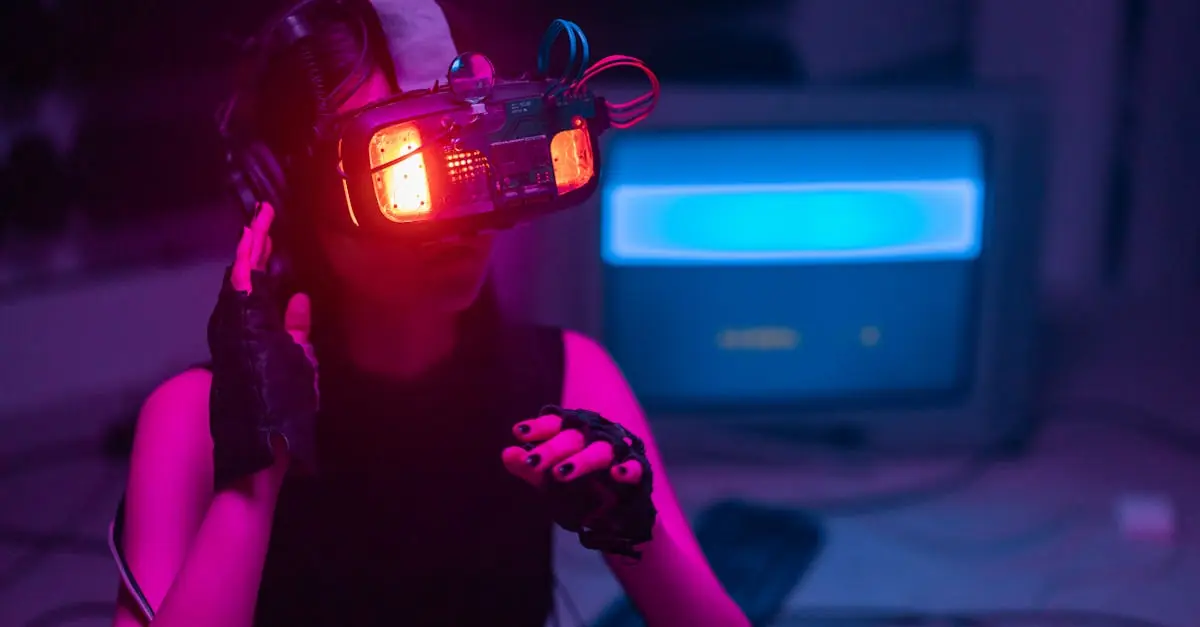Imagine slipping on a pair of gloves that transport you straight into a digital wonderland. VR gloves are the latest game-changer in virtual reality, turning the mundane act of hand movements into a symphony of immersive experiences. Whether it’s high-fiving a digital dinosaur or crafting virtual masterpieces, these gloves make every interaction feel real—minus the risk of a paper cut.
Table of Contents
ToggleOverview of VR Gloves
VR gloves represent a significant leap in virtual reality technology. These devices allow users to engage in immersive experiences by replicating realistic hand movements.
What Are VR Gloves?
VR gloves are specialized wearables designed for virtual environments. They track hand motions and provide tactile feedback, enhancing interactivity. Users can manipulate virtual objects, navigate menus, and engage with environments. With sensors embedded in the gloves, they capture movements with precision. This technology creates a more engaging experience, facilitating interaction with digital aspects in ways traditional controllers cannot.
How Do VR Gloves Work?
VR gloves utilize a combination of sensors and advanced algorithms to operate. Motion sensors detect the position and orientation of each finger. Data from these sensors transmits to a computer or VR headset, creating a real-time representation of movements. Haptic feedback components simulate touch sensations, adding realism to interactions. The gloves connect via wireless signals, ensuring freedom of movement. Developers integrate VR gloves into various applications, ranging from gaming to training simulations, showcasing their versatility.
Benefits of Using VR Gloves
VR gloves provide numerous advantages, enhancing user interactions in virtual environments. These benefits include enhanced immersion and improved interaction.
Enhanced Immersion
Immersion in virtual reality increases significantly with the use of VR gloves. These devices allow users to experience a more realistic environment, bringing digital spaces to life. For instance, feeling the texture of virtual objects creates a sense of presence. Users can engage fully with their surroundings as the gloves precisely track finger movements. The tactile feedback provided by haptic technology further intensifies the experience. By simulating touch sensations, VR gloves eliminate the disconnect between physical and virtual realms. Whether it’s manipulating virtual tools or exploring expansive worlds, these gloves ensure users feel truly present in their digital adventures.
Improved Interaction
Interaction capabilities improve dramatically with VR gloves. Users can point, grab, and manipulate objects in virtual spaces naturally. Advanced sensor technology detects hand movements, translating them seamlessly into the digital environment. This allows for more intuitive controls compared to traditional handheld devices. Users interact with applications in a more engaging way, accelerating learning in training simulations. The gloves enhance gaming experiences, enabling lifelike movements and gestures. Developers continuously explore new applications, demonstrating versatility across industries. In work settings, effective collaboration becomes possible through gesture-based interactions. Overall, these gloves revolutionize how users connect with virtual environments.
Popular VR Gloves on the Market
Several VR gloves currently dominate the market, offering various features and enhancements. These products cater to different user needs and preferences.
Product Comparisons
HaptX Gloves provide unmatched realism with advanced haptic feedback. They use microfluidic technology to simulate textures and sensations. Manus VR Gloves combine lightweight design with precise finger tracking. This makes them ideal for gaming and professional applications. Next, Pimax CRYSTAL Gloves stand out due to their ergonomic design and affordability. They deliver accurate motion capture and ease of use. Finally, Dexta Robotics Gloves create opportunities for realistic interactions in simulation training. Each product presents unique qualities that address specific user demands, making comparisons essential.
User Reviews
Users frequently praise HaptX Gloves for their immersive capabilities. Many users highlight the realistic feel and precision that enhance user experience. Manus VR Gloves receive attention for their adaptability to various platforms. This flexibility allows users to switch between different applications seamlessly. Pimax CRYSTAL Gloves often receive positive comments due to their value for money. Users appreciate the quality without a hefty price tag. Dexta Robotics Gloves gain respect in professional environments for their reliability. Positive feedback emphasizes the gloves’ ability to enhance simulations across industries.
Challenges and Limitations
VR gloves, despite their groundbreaking technology, face several challenges that may affect user adoption and experience.
Affordability
Affordability remains a primary concern for many users. High-quality VR gloves often come with a significant price tag, making them inaccessible for casual consumers. For example, HaptX Gloves and Manus VR Gloves offer advanced features but typically cost several hundred to thousands of dollars. This price range can deter wider market penetration. Many users seek budget-friendly alternatives without compromising essential functionalities. Brands may need to consider producing mid-range options to cater to diverse budgets. Enhanced accessibility can facilitate broader adoption in gaming and educational sectors.
Comfort and Usability
Comfort and usability directly impact user experience. Some VR gloves may lack ergonomic designs, leading to discomfort during extended use. Tight fitting or heavy materials can create fatigue, reducing the immersive experience. Users often report difficulties in adjusting gloves properly, affecting hand movement accuracy. An ideal design should prioritize lightweight materials while ensuring a snug fit. Haptic feedback technology must remain intuitive for seamless interactions. Continuous feedback from users helps manufacturers to improve comfort features and usability aspects. Such enhancements can significantly boost user satisfaction and overall engagement in virtual environments.
Future Trends in VR Gloves
Technological advancements promise to redefine VR gloves, enhancing their functionality and user experience. Innovations in haptic feedback systems will create more nuanced textures, allowing users to feel the surface characteristics of virtual objects realistically. Improved sensors will achieve greater accuracy in tracking finger and hand movements, resulting in seamless virtual interactions. Wireless technology becomes more sophisticated, reducing latency and increasing reliability for immersive experiences. Battery life is also expected to improve significantly, allowing for extended sessions without interruptions.
Potential applications for VR gloves extend far beyond gaming. In the medical field, surgeons can practice intricate procedures in a risk-free environment, honing their skills with realistic feedback. Education settings can utilize VR gloves to make learning more interactive through virtual labs and immersive simulations. In the field of design, engineers and architects can manipulate 3D models directly, enabling faster and more effective collaboration. Additionally, VR gloves can enhance remote teamwork by allowing participants to interact with shared virtual objects, making online meetings more engaging and productive.
VR gloves are set to redefine the way users interact with virtual environments. By providing realistic hand movements and tactile feedback, these wearables enhance immersion and interactivity like never before. As technology continues to advance, the potential applications for VR gloves are vast, spanning gaming, training, and even medical fields.
While challenges like affordability and comfort remain, ongoing innovations promise to address these issues. With a growing variety of products available, users can find gloves that suit their specific needs. The future of VR gloves looks bright, paving the way for more engaging and intuitive virtual experiences.



